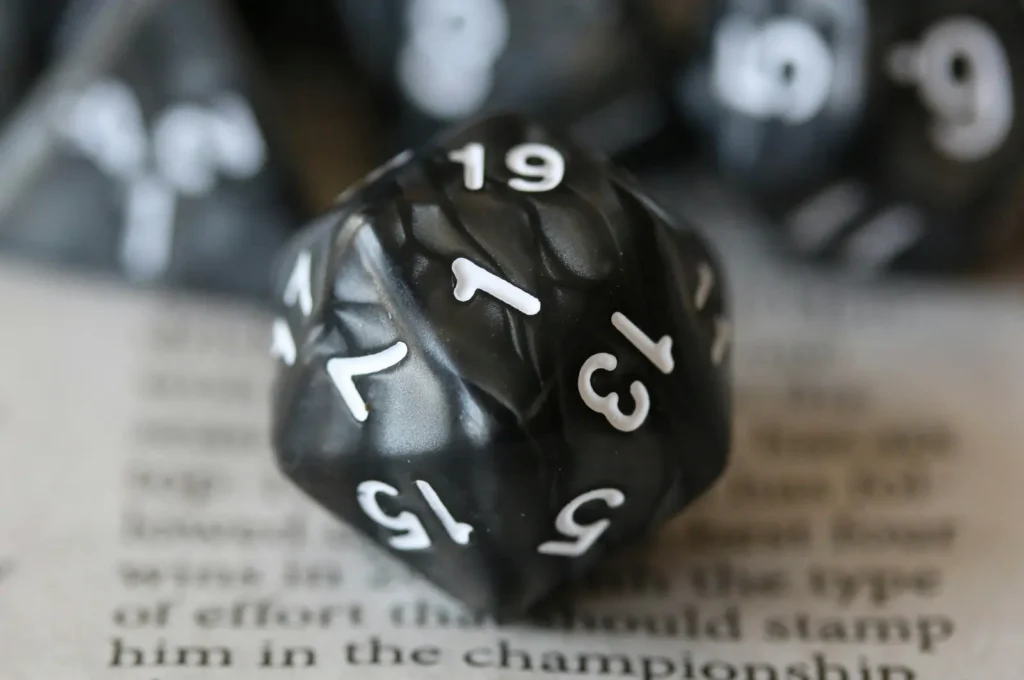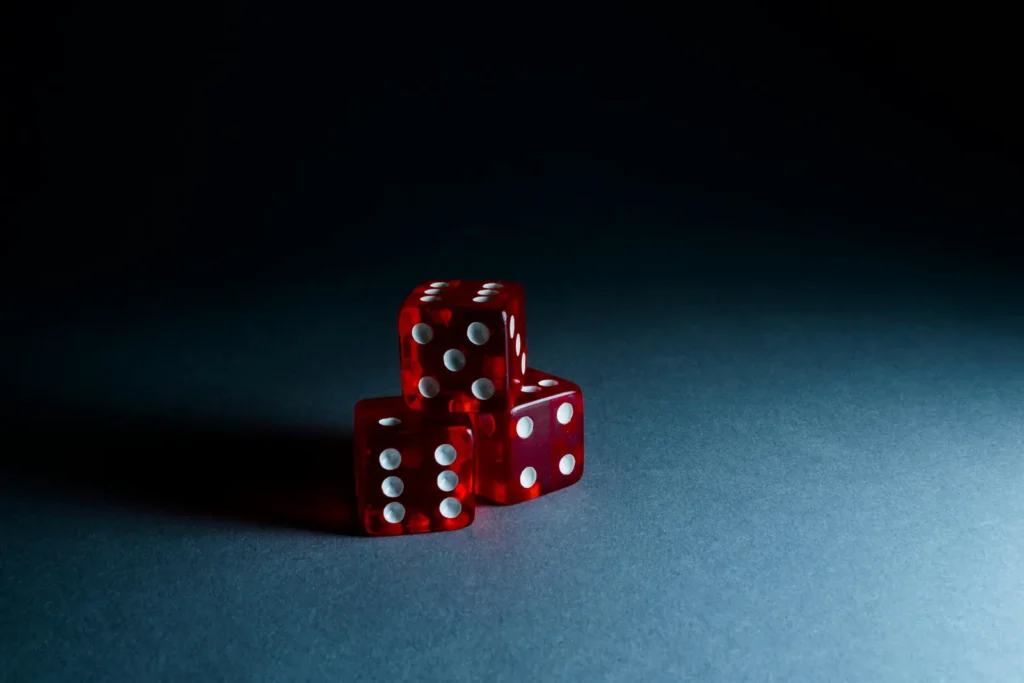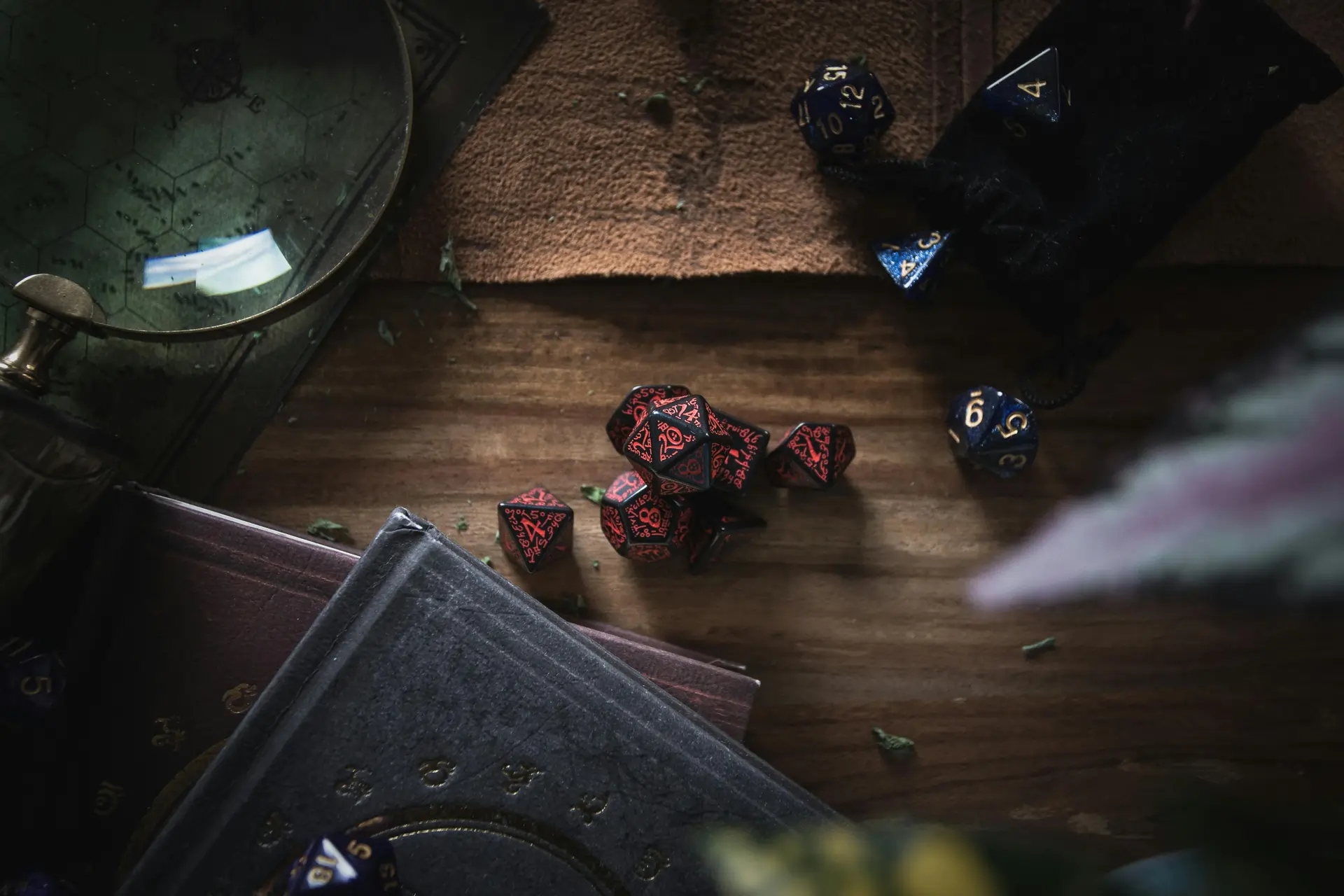Table of Contents
Why TTRPG Dice Systems Matter for Game Design
Tabletop RPGs like Dungeons & Dragons, Pathfinder, Lancer, and Daggerheart each express unique philosophies through their TTRPG Dice Systems. Understanding how these core mechanics influence pacing and player agency helps any GM or designer create their own balanced homebrew TTRPG dice system, designed for both storytelling flow and player agency.
How Dice Shape Emotion and Storytelling in TTRPGs

The dice are the heartbeat of every tabletop game system. The way they feel in the hand and the sound they make, falling on a wooden table or a soft mat. They decide not only what happens, but how it feels when it happens.
A d4 clatters sharply, instantly arriving at a result. It’s fast, cold, and final, like flipping a coin.
A d6 feels familiar, comforting. You’ve held it your whole life, Monopoly, Yahtzee, childhood games.
When it lands, it’s casual, predictable, safe.
But a d12 rolls heavy and deliberate. You can feel its weight , hear it slow before it stops. It demands attention.
And a d20 – that iconic DnD sphere of chaos – takes its time. You roll it, you watch it tumble, and for those few heartbeats the entire table holds its breath. You know the feeling of a nat 20 or that goddamn 1.
The Psychology Behind Rolling Dice in Tabletop RPGs
Dice aren’t just random number generators.
They’re tactile instruments of pacing, tension, and drama.
They give rhythm to combat, uncertainty to exploration, and meaning to every moment of risk.
A dice roll is the fork, before the story changes.
That’s why choosing your core dice system isn’t just about math.
It’s about emotion.
A d20 system says heroes rise or fall in an instant.
A 3d6 curve says the world is fair, skill matters, luck bends but doesn’t break.
A dice pool says effort multiplies, teamwork counts.
Duality dice say every victory carries its shadow.
When designing a TTRPG, the dice are your first design language.
They express what the game believes about the world – whether it rewards risk, honors mastery, or tempts fate.
Because when the dice hit the table, the players and the GM, have to live with the consequences.
Abbreviations
Just as a heads-up, I’ll use a few abbreviations to improve readability in the mechanics section. Here are the ones I’ll use, you probably know them already:
DC: Difficulty Class, the number you need to beat with your roll
dX: An X-sided die (for example, a d12 or d20). Multiple dice are written as 2d12 → two twelve-sided dice
Comparing Probability Curves of the Most Common TTRPG Dice Systems
| System | Roll Type | Success Distribution | Volatility | Player Agency |
|---|---|---|---|---|
| d20 | Flat | Even 5% per step | High | Moderate |
| 3d6 | Bell Curve | Centered around 10–11 | Low | High |
| 2d10 Tier | Semi-Curved | Clustered mid-high | Moderate | Moderate |
| Dice Pool | Success Count | Variable | Medium–High | High |
| Duality (2d12) | Dual Curve | Mixed Results Frequent | Medium | Very High |
The fewer dice you roll, the louder they speak. The more you roll, the smoother their voice becomes.
– Some Redditor, probably
What Are the Most Common TTRPG Dice Systems?
Single Dice Rolls: The d20 System
Examples: D&D, Pathfinder, LANCER attacks
Mechanic:
Roll one dice and add Modifiers on top vs a Difficulty Class (DC)
Resolution:
Critical Success: The highest possible number shows up (20 on a d20).
Success: Roll + Modifier is higher than DC.
Success with Complication: Optional homebrew rule for near-misses.
Failure: Roll + Modifier is lower than DC.
Critical Failure: The lowest possible number (1 on a d20).
Comment:
Fast, familiar, and heroic — but very swingy. Each +1 adds roughly 5% to your success chance.
The New Kid in Town: Duality Dice (Hope vs. Fear)
Examples: Daggerheart, Genesys, Nyora
Mechanic:
Roll two of the same dice, often representing narrative forces (Hope/Fear, Light/Shadow)
Resolution:
Critical Successs → All Doubles (1+1, 2+2, … 12+12)
Success → Both Dice + Modifier higher than DC and Light Dice higher than Dark Dice.
Success with complication → Both Dice + Modifier higher than DC and Light Dice lower than Dark Dice.
Failure → Both Dice + Modifier lower than DC and Light Dice higher than Dark Dice.
Critical Failure → Both Dice + Modifier lower than DC and Light Dice lower than Dark Dice.
Comment:
Creates natural tension and cinematic “partial wins.” Perfect for story-first design in TTRPG systems that thrive on consequence. You can combine this easily with the d20 system by using the d20 for all normal throws, and when the stakes are high grab those 2d12s to make the moment feel extra special. Great to homebrew into your DnD 5e campaign.
Multi-Dice Linear Systems

Mechanic:
Roll multiple dice (usually 3d6), add them together, then add modifiers and compare the total to a DC. GURPS uses a roll under system, there are also roll over systems like Nimble.
Resolution:
Critical Success: If you roll all Ones in GURPS or all Sixes in other systems.
Success: Roll + Modifier is higher than DC.
Success with Complication: Optional homebrew rule for near-misses.
Failure: Roll + Modifier is lower than DC.
Critical Failure: If you roll all Sixes in GURPS or all Ones in other systems.
Comment:
Smooth, predictable outcomes. Curved probability keeps rolls consistent, less “all or nothing.”
Each +1 bonus drastically improves midrange rolls (especially near 10–12).
Dice Pools
Examples: Exalted, World of Darkness, LANCER checks
Mechanic:
Roll a pool of dice, usually d6s or d10s. Each die that meets or exceeds a target number counts as one success.
The total number of successes determines the outcome.
Resolution:
Critical Success: Exceed the required successes by a wide margin, or roll multiple 10s (e.g., doubles = “exploding” dice).
Success: Achieve the required number of successes.
Success with Complication: Meet the threshold exactly or roll negative symbols alongside successes (in mixed-symbol systems).
Failure: Fewer successes than required.
Critical Failure: Zero successes and one or more 1s (botch).
Comment:
Tactile, cinematic, and scalable. More dice increase reliability, but every roll carries tension. Ideal for games emphasizing teamwork, luck, and dramatic pacing.
Tiered Dice Systems: Thresholds of Success
Examples: Draw Steel, Ironsworn
Mechanic:
Roll 2d10 + Modifiers, then compare the total to fixed “Tiers” that define the outcome.
Each range represents a qualitative degree of success, not just a binary pass/fail.
Resolution:
Tier 1: 1–11 → Failure or Success with major cost
Tier 2: 12–16 → Solid Success
Tier 3: 17+ Exceptional or Critical Success
Comment:
Visually rewarding and easy to grasp. The dice tell how well you succeeded, not just if. Perfect for tactical-narrative hybrids where margin matters.
Step Dice Systems: Scaling by Die Size
Examples: Savage Worlds, Cortex Prime, Nyora
Mechanic:
Attributes, skills, and traits are represented by different die sizes rather than flat bonuses.
For example, a novice might roll a d4, while an expert rolls a d10 or d12.
When you advance, you “step up” your die — from d6 to d8, d8 to d10, and so on.
Resolution:
Critical Success: Max roll on your die.
Success: Roll + Modifiers meets or exceeds the DC.
Partial Success: Optional margin range (1–2 points below DC).
Failure: Total below DC.
Critical Failure: Minimum roll (1).
Comment:
Progression feels physical, going from a d6 to a d12 feels like leveling up.
Ideal for cinematic, pulpy systems that want fast math and visible growth curves.
Additional Dice Mechanics
Exploding Dice
Mechanic:
When a die rolls its maximum value, you roll it again and add the new result to the total.
This can repeat indefinitely if you keep rolling max values. Systems like Nimble 2e use this for critical hits in combat.
Comment:
Lower damage dice can crit more often, making lighter weapons feel different from larger weapons. Skipping the attack roll can make the game feel faster. However, it also increases variance dramatically, so it fits best in cinematic or heroic TTRPG dice systems where big moments matter more than statistical balance.
Advantage and Disadvantage
Mechanic:
Roll two dice of the same type and take either the higher (Advantage) or lower (Disadvantage) result. Some systems use this with even more dice and keep only the highest or lowest.
Effect:
This doesn’t add flat bonuses, it reshapes probability.
Advantage skews results toward success without eliminating failure, while Disadvantage pushes rolls toward the lower range.
Comment:
Simple to explain, powerful in play.
Mathematically, Advantage on a d20 is roughly equivalent to a +3 to +5 bonus, but with far smoother feel at the table.
Degrees of Success / Failure
Mechanic:
Instead of just success or failure, the degree by which you succeed (or fail) determines narrative impact or mechanical advantage.
Effect:
Succeeding by 1 vs. 10 feels different, and has different outcomes.
Margins create natural tension in slower, more grounded systems.
Comment:
Excellent for simulationist, tactical and narrative play, but slower at the table. In Nyora we use this to make combats more engaging, by not only checking if you hit a target, but also if its a grazing, normal, severe or critical hit.
Fumble / Botch Mechanics
Mechanic:
Introducing a critical failure.
Effect:
Not only do you miss the attack, but you hit the stonefloor with such a massive force, that your sword breaks.
Comment:
Adds stakes to every roll. Makes the dice feel dangerous and alive. Best used sparingly. Fumbles are thrilling in moderation, frustrating in repetition.
Fail Forward Mechanics
Mechanic:
Instead of pass or fail, every roll advances the story.
A success might come with a cost, a failure might open new paths or reveal information.
The dice determine how you succeed — not if you do.
Effect:
This breaks the binary “hit or miss” logic of older systems.
Every outcome is narratively meaningful:
A close “success” might mean you hit the target but lose your footing.
A close “failure” might mean you open the door but alert the guards.
Comment:
Perfect for story-driven and collaborative games. Adds stakes to every roll. It keeps momentum flowing even when the dice say “no,” transforming randomness into creativity. Can be taxing on the GM to come up with consequences.
Push / Burn / Stress Mechanics
Mechanic:
Players can push their luck, re-roll, add dice, or boost effects, by taking on stress, exhaustion, or risk.
Effect:
Encourages dramatic, character-driven choices.
You can always succeed if you’re willing to pay the cost.
Comment:
Perfect for narrative systems where emotion, fatigue, or consequence are part of the fun.
Dice System Reference Chart
| System Type | Core Mechanic | Example Games | Strengths | Weaknesses |
|---|---|---|---|---|
| d20 | Roll + Modifier vs DC | D&D, Pathfinder | Fast, simple | Swingy |
| Duality | Two opposing dice | Daggerheart, Nyora | Narrative tension | Complex to teach |
| Linear (3d6) | Roll-under Skill | GURPS | Realistic curve | Less heroic feel |
| Dice Pool | Count successes | Exalted, WoD | Tactile, team focus | Slower math |
| Step Dice | Scale die size | Savage Worlds | Feels physical | Explosive randomness |
How to Design Your Own TTRPG Dice System (Step-by-Step)
If you want to design your own dice system, start by deciding:
- What do you want players to feel? (Power, danger, cooperation?)
- How do you want progress to look? (Flat bonus, step-up, new dice?)
- What kind of randomness fits your tone? (Heroic chaos or tactical control?)
Dice are the heartbeat of a TTRPG. They don’t just determine success — they define rhythm, emotion, and story pacing. Whether you’re designing your own homebrew TTRPG dice system or exploring tabletop RPG mechanics, understanding how dice shape narrative tension is what turns rules into storytelling.
